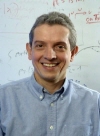 |
|
|
|
| |
 |
|
| |
| |
 |
 Plenary Talk I - October 26(WED), 2011 (11:00~12:00) Plenary Talk I - October 26(WED), 2011 (11:00~12:00) |
 Prof. Masayoshi Tomizuka Prof. Masayoshi Tomizuka
(Dept. of Mechanical Engineering, University of California / USA)
|
 |
 Enhancing Human Machine Interaction via Mechatronic Actuation Enhancing Human Machine Interaction via Mechatronic Actuation |
 Abstract: Mechatronics technologies are applied to assist human in many ways.
One type of assistance is physical in the sense that actuators supply force and torque so that human may accomplish certain tasks with smaller mascular force. In this talk, we will examine three different problems of this kind of assistance:
1) mobility assistance for elderly and partially impaired patients, 2) electric bicycle and 3) variable-gear-ratio steering system for automobiles. Actuators for mobility assistance must generate reasonably large torque while the size and weight be not excessive.
These requirements make indirect drive motors as opposed to direct drive motors unique design choice. Further important requirement is that the motor system must be back-drivable for human’s comfort and safety. It will be shown that the mechatronic consideration based
on series elastic actuation and disturbance observer makes it possible to design a back-drivable light weight high torque actuation system. In electric bicycle, the human pedal torque is measured and a motor supplies an extra torque to assist the rider. One unique feature
of the human pedal torque is that it is not constant but varies over a pedal cycle: human’s pedal toque is large or small depending on the pedal angles. If we identify such time varying patterns, the motor torque can be varied so that the total torque, i.e.
human torque plus motor torque, may remain close to a constant value. It will be shown that such a way of generating motor torque is indeed possible, and it helps the rider as well as the stability of bicycle in various scenarios such as climbing hills.
In variable-gear-steering, the gear ratio is varied as a function of the vehicle speed to change operability. One big problem in such steering systems is the unnatural reaction torque caused by the variable actuator.
A concept called friction relocation is introduced to overcome this problem. Abstract: Mechatronics technologies are applied to assist human in many ways.
One type of assistance is physical in the sense that actuators supply force and torque so that human may accomplish certain tasks with smaller mascular force. In this talk, we will examine three different problems of this kind of assistance:
1) mobility assistance for elderly and partially impaired patients, 2) electric bicycle and 3) variable-gear-ratio steering system for automobiles. Actuators for mobility assistance must generate reasonably large torque while the size and weight be not excessive.
These requirements make indirect drive motors as opposed to direct drive motors unique design choice. Further important requirement is that the motor system must be back-drivable for human’s comfort and safety. It will be shown that the mechatronic consideration based
on series elastic actuation and disturbance observer makes it possible to design a back-drivable light weight high torque actuation system. In electric bicycle, the human pedal torque is measured and a motor supplies an extra torque to assist the rider. One unique feature
of the human pedal torque is that it is not constant but varies over a pedal cycle: human’s pedal toque is large or small depending on the pedal angles. If we identify such time varying patterns, the motor torque can be varied so that the total torque, i.e.
human torque plus motor torque, may remain close to a constant value. It will be shown that such a way of generating motor torque is indeed possible, and it helps the rider as well as the stability of bicycle in various scenarios such as climbing hills.
In variable-gear-steering, the gear ratio is varied as a function of the vehicle speed to change operability. One big problem in such steering systems is the unnatural reaction torque caused by the variable actuator.
A concept called friction relocation is introduced to overcome this problem.
|
|
 |
 Plenary Talk Ⅱ - October 27(THU), 2011 (11:00~12:00) Plenary Talk Ⅱ - October 27(THU), 2011 (11:00~12:00) |
 Prof. Wolfram Burgard Prof. Wolfram Burgard
(Dept. of Computer Science, Univ. of Freiburg / Germany)
|
 |
 Probabilistic Techniques for Mobile Robot Navigation Probabilistic Techniques for Mobile Robot Navigation
|
 Abstract: Probabilistic approaches have been discovered as one of the most
powerful approaches to highly relevant problems in mobile robotics
including robot state estimation and localization. Major challenges in
the context of probabilistic algorithms for mobile robot navigation
lie in the questions of how to deal with highly complex state
estimation problems and how to control the robot so that it
efficiently carries out its task. In this talk, I will discuss both
aspects and present recently developed techniques for efficiently
learning a map of an unknown environment with a mobile robot using
particle filters. I will also describe how the complexity of this
state estimation problem can be reduced by actively controlling the
vehicle. For all algorithms I will present experimental results that
have been obtained with mobile robots in real-world environments. I
will conclude the presentation with a discussion of open issues and
potential directions for future research. Abstract: Probabilistic approaches have been discovered as one of the most
powerful approaches to highly relevant problems in mobile robotics
including robot state estimation and localization. Major challenges in
the context of probabilistic algorithms for mobile robot navigation
lie in the questions of how to deal with highly complex state
estimation problems and how to control the robot so that it
efficiently carries out its task. In this talk, I will discuss both
aspects and present recently developed techniques for efficiently
learning a map of an unknown environment with a mobile robot using
particle filters. I will also describe how the complexity of this
state estimation problem can be reduced by actively controlling the
vehicle. For all algorithms I will present experimental results that
have been obtained with mobile robots in real-world environments. I
will conclude the presentation with a discussion of open issues and
potential directions for future research.
|
|
 |
 Plenary Talk Ⅲ - October 28(FRI), 2011 (11:00~12:00) Plenary Talk Ⅲ - October 28(FRI), 2011 (11:00~12:00) |
 Prof. Sigurd Skogestad Prof. Sigurd Skogestad
(Dept. of Chemical Engineering
, Norwegian University of Science and Technology (NTNU), Norway)
|
 |
 Plantwide Control: Control Structure Design for Complete Processing Plants Plantwide Control: Control Structure Design for Complete Processing Plants |
 Abstract: A chemical plant may have thousands of measurements and control loops.
By the term plantwide control it is not meant the tuning and behavior of each of these loops, but rather the control philosophy of the overall plant with emphasis on the structural decisions. In practice, the control system is usually
divided into several layers, separated by time scale: scheduling (weeks) , site-wide optimization (day), local optimization (hour), supervisory (predictive, advanced) control (minutes) and regulatory control (seconds). Such a hiearchical
(cascade) decomposition with layers operating on different time scale is used in the control of all real (complex) systems including biological systems and airplanes, so the issues in this section are not limited to process control.
In the talk the most important issues are discussed, especially related to the choice of variables that provide the link the control layers. Abstract: A chemical plant may have thousands of measurements and control loops.
By the term plantwide control it is not meant the tuning and behavior of each of these loops, but rather the control philosophy of the overall plant with emphasis on the structural decisions. In practice, the control system is usually
divided into several layers, separated by time scale: scheduling (weeks) , site-wide optimization (day), local optimization (hour), supervisory (predictive, advanced) control (minutes) and regulatory control (seconds). Such a hiearchical
(cascade) decomposition with layers operating on different time scale is used in the control of all real (complex) systems including biological systems and airplanes, so the issues in this section are not limited to process control.
In the talk the most important issues are discussed, especially related to the choice of variables that provide the link the control layers.
|
|
|
|
|
|
